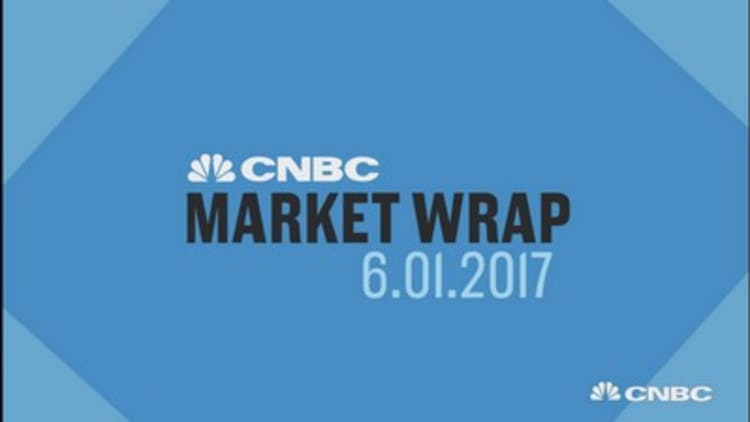
U.S. equities closed higher on Thursday, the first trading day in June, as Wall Street got ready for the release of the monthly jobs report.
The Nasdaq composite gained about 0.8 percent, hitting intraday and record highs. The S&P 500 also rose nearly 0.8 percent to notch all-time highs, with materials, financials and health care leading advancers. The health care sector also reached its first 52-week high since March 15.
The Dow Jones industrial average rose about 135 points, with UnitedHealth and Goldman Sachs contributing the most gains. The 30-stock index also traded about 25 points away from its intraday record.
Economists polled by Reuters expect the U.S. economy to have added 185,000 jobs last month. But David Kelly, chief global strategist at JPMorgan Funds, said expectations may have increased in the market after a strong report from ADP and Moody's Analytics.
The Thursday report said private payrolls surged by 253,000 in May, easily topping a consensus estimate of 185,000.
"It was a very good, positive surprise. We've had a few negative surprises, so this is definitely against the current," said JPMorgan Funds' Kelly. "Overall, it says the economy is still moving along nicely."
The report from ADP and Moody's is often seen as a preview to the U.S. government's nonfarm payrolls report, which is set for release Friday at 8:30 a.m.
"What the ADP number does is it raises expectations that the jobs report can come at the top end of the range and maybe above the estimate," said JJ Kinahan, chief market strategist at TD Ameritrade.
Wall Street had a slew of data to digest Thursday, including weekly jobless claims, which came in at 248,000, above a forecast of 239,000. The ISM manufacturing index for May came in at 54.9, just below an estimate of 55.0. April construction spending fell 1.4 percent with economists forecasting a gain of 0.5 percent.
Auto companies, meanwhile, released monthly vehicle sales throughout the day.
Nevertheless, these data — along with Friday's jobs report — will do little to dissuade the Federal Reserve from raising rates later this month.
"They have been telegraphing their moves clearly," said Jason Thomas, chief economist at AssetMark. "They want to raise rates." Thomas also noted that the central bank feels "vindicated" following the criticism directed for the way it has handled monetary policy in the past few years.
"My sense is that they see themselves in smooth waters right now, but those waters are shallow and there are rocks beneath," he said. "Unemployment is really low, but labor force participation has barely budged."
The Fed is set to meet June 13 and 14, with market expectations for a rate hike at 95.8 percent, according to the CME Group's FedWatch tool.
The Dow,
The CBOE Volatility Index (VIX), widely considered the best gauge of fear in the market, broke below 10 six times last month, hitting levels not seen in more than 20 years.
"Investors worry that the relationship between decreasing volatility and increased purchases could morph from a virtuous cycle to self-fulfilling feedback frenzy, leading to a vicious, volatility induced selloff," said Jack Ablin, chief investment officer at BMO Private Bank.
"The extent of a potential downdraft depends on how large the risk-parity investment community is. It's widely believed that the mass of money managed under a risk-parity mandate remains small, although it's a trend worth watching," Ablin said in a note.
Tech stocks were among the best performers as the sector continued to build on its stellar year-to-date gains. Tech has gained nearly 20 percent in 2017. By comparison, consumer discretionary, the second-best-performing sector, is up 12 percent.
"Most of the growth has come from large-cap growth stocks," said Tom Martin, senior portfolio manager at
In corporate news, shares of
Meanwhile, Marathon Petroleum approved an additional $3 billion to its shares repurchase program.
Major U.S. Indexes
On tap this week:
The Dow Jones industrial average rose 135.53 points, or 0.65 percent, to close at 21,144.18, with UnitedHealth leading advancers.
The gained 18.26 points, or 0.76 percent, to end at 2,430.06, with financials leading all sectors higher.
The Nasdaq advanced 48.31 points, or 0.78 percent, to close at 6,246.83.
About five stocks advanced for every decliner at the New York Stock Exchange, with an exchange volume of 974.08 million and a composite volume of 3.839 billion at the close.
Friday
Earnings: Hovnanian
8:30 a.m. Employment
8:30 a.m. International trade


